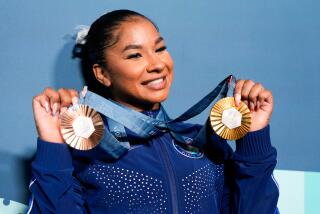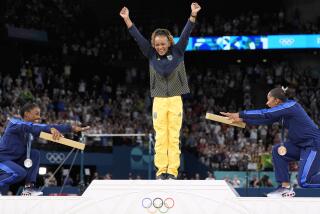A Perfect Moment
As she stood on the runway, ready to power down the mat and plant her chalky hands on the vault horse, Mary Lou Retton thought, “10!”
She was an optimist, after all, and if she needed a perfect score to win a gold medal, she was going to get one.
The 16-year-old girl from Fairmont, W.Va., stood only 4 feet 8 and weighed 92 pounds. She had turned to her personal coach, Bela Karolyi, a moment earlier and said, “I’m going to get a 10.”
Karolyi replied, “Yes.”
And Mary Lou Retton got her 10.
It might be the most famous gymnastics score in history.
Her face was scrunched in concentration, the sound of her pounding feet the only noise in an otherwise silent Pauley Pavilion. Then came the slap of her hands on the horse, and Retton “stuck” her landing, as they say in gymnastics, her feet hitting the floor and staying still as if glued there, making for one of those goose-bump moments that are remembered forever.
“I’ll never forget it,” said Don Peters, coach of that U.S. team. Peters, who still coaches at SCATS in Huntington Beach, remembers the evening as magical.
“Mary Lou wasn’t the favorite,” he recalled. “But when it got down to the end, what we had to remember about Mary Lou is that she always thought things would turn out well. She believed in herself.”
It wasn’t the first 10 at an Olympics. That honor belonged to Nadia Comaneci, the 14-year-old Romanian who gathered up seven of them over the course of the 1976 competition in Montreal.
But Comaneci was an introverted Eastern European girl from a country without much freedom, or Wheaties boxes, but with plenty of Olympic gymnastics medals.
Retton was the underdog from the host country and on a team unaccustomed to Olympic success.
Before 1984, no U.S. woman had won gymnastics gold in any individual event or the all-around. And despite the Soviet-led boycott in 1984, the mighty Romanians and the on-the-rise Chinese gymnasts had come.
Ecaterina Szabo of Romania was the favorite. Even on the U.S. team, Retton was considered no more than co-No. 1 with Julianne McNamara. And Retton had undergone knee surgery two months earlier to remove torn cartilage.
Before the 1984 Olympics, women’s gymnastics had not done well in the United States. Olga Korbut, the sprite on the 1972 Soviet Union team, had captured hearts in the way she overcame an early fall to win individual medals. Korbut’s charisma -- she taught the world that Soviet athletes could smile -- had caught the eyes of thousands of little American girls and gyms were opening around the country.
But the U.S.-led boycott of the 1980 Olympics in Moscow had pushed the sport out of American minds.
“By 1983, gyms all over the country were closing,” Peters said. “People had kind of forgotten about the sport, with no Olympic exposure for eight years.”
By the night of Aug. 3, 1984, Retton had taken a minuscule lead over Szabo. Retton skipped into Pauley Pavilion as a favorite of the crowd but of no one else.
Szabo and Retton competed in different rotations all evening, with Szabo usually up first. Szabo began her routines on the balance beam, and Retton started on the uneven bars.
Right away, Szabo staked her gold medal claim by scoring a 10. After the first round, Szabo had pulled into a tie in the all-around with Retton. After two rounds, Szabo had gone ahead by earning a 9.95 in the floor exercise to Retton’s 9.80 on the balance beam, her routine marred by shaky landings on her forward flip and a back walkover. Szabo was now ahead by .15 of a point.
“I didn’t pay that much attention to what Szabo was doing,” Retton said recently. “But I knew she was doing good and that I needed to be almost perfect.”
On the third of four rotations, Szabo earned a 9.90 on her vault. Retton had brought the Pauley crowd to its feet, though, by performing a rollicking floor exercise filled with enough energy to light up the night. As the crowd roared, Retton’s floor exercise score was flashed -- 10.
With one more rotation for each girl, Szabo led, 69.225 to 69.175.
For her final, Szabo threw herself fully into her uneven bars routine. She was a twisting, turning, twirling dervish, scoring 9.90 for a total of 79.125.
Retton knew what she needed. If she got a 9.95, she would tie for gold, a historic achievement. With a 10, Retton would win the gold alone.
“All I could think was, ‘Stick it! Stick it! Stick it!’ ” Retton said.
With the vault, that was the key. Landing on the mat and not moving.
“We all knew what Mary Lou had to do,” Karolyi said. “We all knew she could do it. ‘Do it! Do it,’ I tell her. ‘Do it, Mary Lou.’ ”
Since he wasn’t the team coach, Karolyi wasn’t allowed on the floor, so Retton ran to the boards.
“You’re going to do it,” Karolyi shouted at Retton. “I know you can do it. Now or never, OK?”
Retton remembers smiling at Karolyi. “I think I told him, ‘OK,’ ” she said.
Eight years earlier, as she lay on the floor in her West Virginia home, watching on TV as Comaneci won the all-around gold medal, Retton fell in love with gymnastics. She had been so competitive and such a good athlete that her family sacrificed and sent her to Texas to train with Karolyi, who had coached Comaneci.
And now Retton had her moment.
“I remember all the noise,” Retton said. “I remember Pauley was all red, white and blue, and it was so loud. It was rocking, it was incredible, and I never underestimate the power of momentum.”
It was more than momentum. Retton was a bundle of power and confidence. Her hands hit the horse perfectly. Her arms were twisted into her body tightly and on the landing there was a slight bounce but not a toe out of place. A stick.
It took the scoreboard about 30 seconds to flash the total but the coaches knew sooner.
“We were all going berserk,” Peters said. “We knew what she had done.”
In the midst of the bedlam, Retton had a second vault to perform, the best one counting. Retton scored a 10 on her second vault too.
“I don’t think any of us could have expected what came next,” Peters said.
Certainly not Retton.
“I thought I’d just go home and be normal,” she said. “I never expected all the fame. I don’t know why I became such a big deal. I guess maybe America was just ready for it.”
Szabo actually had the better Olympics. She went home with four gold medals -- one team and one each in the vault, uneven bars and floor exercise -- plus a silver on the balance beam. Retton’s only gold was in the all-around. She also earned a team silver, an individual silver in the vault and bronze on the bars and in floor exercise.
But it was Retton whose face was on the Wheaties box, and Retton who gained international fame.
Retton, now 36, married former University of Texas quarterback Shannon Kelly and has four daughters -- Shayla, 9; McKenna, 7; Skyla, 4; and Emma, 2. She lives in Houston and delivers motivational speeches around the country. In 1997, Retton was inducted into the International Gymnastics Hall of Fame.
Szabo, 36, married Christian Tomas, a former member of Romania’s kayak team and has a son, Lorenzo. In 1992, she and her family moved to France, where she coaches gymnastics. In 2000, Szabo was inducted into the International Gymnastics Hall of Fame.
More to Read
Go beyond the scoreboard
Get the latest on L.A.'s teams in the daily Sports Report newsletter.
You may occasionally receive promotional content from the Los Angeles Times.






